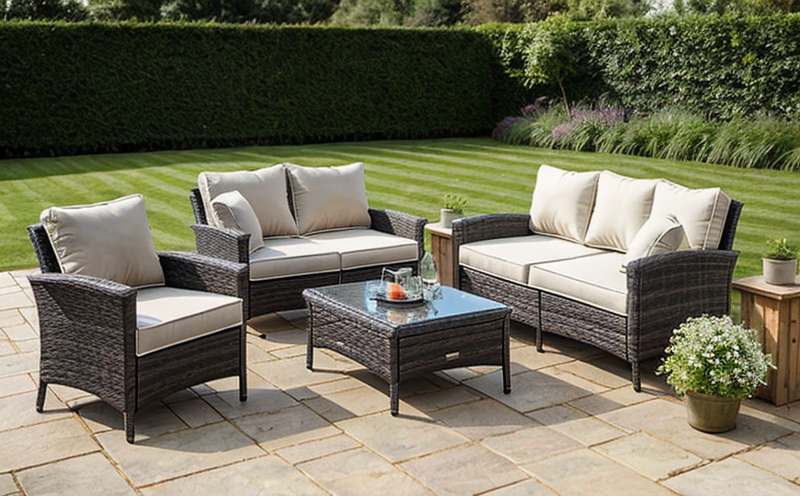BS EN 1730 Outdoor Furniture Strength and Stability of Joints Testing
The British Standard EN 1730 specifies methods for determining the strength and stability of joints in outdoor furniture. This standard is crucial for ensuring that furniture can withstand environmental stresses, including wind, rain, and UV radiation. Compliance with this standard ensures that products meet high quality and safety standards, which are essential for both consumer protection and market access.
The testing process involves several stages, each designed to simulate real-world conditions that outdoor furniture may encounter. These tests help manufacturers identify potential weaknesses in their designs and materials, enabling them to improve product performance and durability. The standard applies not only to the joints themselves but also to the overall structural integrity of the furniture.
Strength testing typically involves applying gradually increasing loads to specific points on the furniture to determine how much weight or force it can support before failing. Stability tests focus on ensuring that the furniture remains stable under various conditions, such as wind resistance and uneven ground surfaces. This ensures that users can safely enjoy outdoor spaces without worrying about structural failures.
Environmental factors play a significant role in the durability of outdoor furniture. Exposure to UV radiation can cause materials to degrade over time, leading to color fading or material breakdown. Wind loads are another critical factor, as they can exert considerable force on lightweight structures like chairs and tables. Rain exposure also contributes to corrosion and degradation, especially if the furniture is made from metal components.
Material selection is vital in achieving compliance with BS EN 1730. Common materials used include aluminum, steel, plastic, and composite materials. Each material type has its advantages and challenges when it comes to meeting the requirements of this standard. Aluminum, for instance, offers excellent corrosion resistance but may not be as strong under heavy loads compared to steel. Plastic furniture is lightweight and durable but can degrade more quickly due to UV exposure.
Testing procedures are designed to simulate realistic conditions that outdoor furniture faces in everyday use. Wind tunnel tests, for example, help determine how well the furniture stands up against gusts of wind. Rain chamber tests expose samples to prolonged periods of simulated rain to assess water resistance and durability. Additionally, laboratories may conduct thermal cycling tests to evaluate how materials respond to temperature fluctuations.
To ensure accurate testing results, specimens must be prepared according to strict guidelines outlined in the standard. This includes cleaning the surface thoroughly, ensuring all fasteners are securely attached, and positioning the specimen correctly within the test apparatus. Proper preparation ensures that any failures observed during testing can be attributed to structural weaknesses rather than improper setup.
Instrumentation plays a crucial role in conducting these tests accurately and efficiently. Load cells measure applied forces during strength tests, while strain gauges provide real-time data on deformation levels. Video cameras capture movement patterns throughout stability evaluations, allowing analysts to identify any issues promptly. Data acquisition systems compile all collected information into comprehensive reports that guide further development efforts.
| Application | Description |
|---|---|
| Safety Assurance | Evaluates the safety aspects of outdoor furniture to protect consumers from potential hazards. |
| Durability Assessment | Ensures that products can withstand environmental stresses over extended periods, enhancing customer satisfaction. |
| Quality Control | Identifies defects early in the manufacturing process before they reach end users. |
| Product Development | Provides insights into material performance and structural design improvements necessary for competitive advantage. |
| Application | Description |
|---|---|
| Market Compliance | Aids manufacturers in meeting regulatory requirements and ensuring products are suitable for international markets. |
| User Experience Optimization | Focusses on enhancing the overall user experience by identifying comfort factors, ease of use, and aesthetic appeal. |
| Environmental Impact Reduction | Lowers the environmental impact associated with product lifecycle through optimized design and material selection. |
| Brand Reputation Protection | Builds trust among consumers by delivering reliable products that meet or exceed expectations. |
- Achieves regulatory compliance for international markets
- Enhances brand reputation through consistent product quality
- Improves user experience with safer, more durable furniture
- Promotes sustainable practices by minimizing waste and resource consumption
- Facilitates easier entry into new geographic regions
- Reduces liability risks associated with product failures
- Supports continuous improvement initiatives within R&D departments
- Fosters long-term customer loyalty through reliable products





